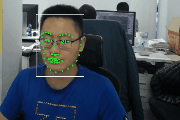Pytorch version of 'How far are we from solving the 2D & 3D Face Alignment problem? (and a dataset of 230,000 3D facial landmarks)'
For official torch7 version please refer to face-alignment-training [https://github.com/1adrianb/face-alignment-training]
This is a reinplement of training code for 2D-FAN and 3D-FAN decribed in "How far" paper. Please visit author's webpage [https://www.adrianbulat.com] or arxiv [https://arxiv.org/abs/1703.07332] for technical details.
Thanks for bearpaw's excellent work on human pose estimation [https://github.com/bearpaw/pytorch-pose] . And in this project, I reused a branch of helper function from pytorch-pose.
Pretrained models are available soon.
- Install the latest Pytorch [http://pytorch.org], version 1.0.0.
- [https://www.scipy.org/][scipy]
- [https://pytorch.org][torchvision]
- [https://pypi.python.org/pypi/progress] progress (optional) for better visualization.
-
Clone the github repository and install all the dependencies mentiones above.
git clone https://github.com/lippman1125/pytorch_FAN -
Download the LS3D-W dataset from the authors webpage (https://www.adrianbulat.com/face-alignment).
-
Download the 300W-LP annotations converted to t7 format by paper author from (https://www.adrianbulat.com/downloads/FaceAlignment/landmarks.zip).
-
We merge LS3D-W dataset and 300W-LP dataset together to train our model.
cd data/LS3D-W
tree -d -L 1|-- 300VW-3D |-- 300W-Testset-3D |-- 300W_LP |-- AFLW2000-3D-Reannotated `-- Menpo-3DValidation set is testset of 300W-LP
-
Start to train:
./exp/train.sh
-
Run the demo.
python demo_video.py gpu
- Train FAN only includes 2 Hourglass
- Total Params: 11.55M
{
@inproceedings{bulat2017far,
title={How far are we from solving the 2D \& 3D Face Alignment problem? (and a dataset of 230,000 3D facial landmarks)},
author={Bulat, Adrian and Tzimiropoulos, Georgios},
booktitle={International Conference on Computer Vision},
year={2017}
}
